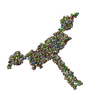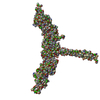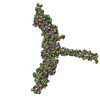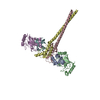+Search query
-Structure paper
| Title | RNF8 E3 Ubiquitin Ligase Stimulates Ubc13 E2 Conjugating Activity That Is Essential for DNA Double Strand Break Signaling and BRCA1 Tumor Suppressor Recruitment. |
|---|---|
| Journal, issue, pages | J Biol Chem, Vol. 291, Issue 18, Page 9396-9410, Year 2016 |
| Publish date | Apr 29, 2016 |
 Authors Authors | Curtis D Hodge / Ismail H Ismail / Ross A Edwards / Greg L Hura / Andrew T Xiao / John A Tainer / Michael J Hendzel / J N Mark Glover /    |
| PubMed Abstract | DNA double strand break (DSB) responses depend on the sequential actions of the E3 ubiquitin ligases RNF8 and RNF168 plus E2 ubiquitin-conjugating enzyme Ubc13 to specifically generate histone Lys-63- ...DNA double strand break (DSB) responses depend on the sequential actions of the E3 ubiquitin ligases RNF8 and RNF168 plus E2 ubiquitin-conjugating enzyme Ubc13 to specifically generate histone Lys-63-linked ubiquitin chains in DSB signaling. Here, we defined the activated RNF8-Ubc13∼ubiquitin complex by x-ray crystallography and its functional solution conformations by x-ray scattering, as tested by separation-of-function mutations imaged in cells by immunofluorescence. The collective results show that the RING E3 RNF8 targets E2 Ubc13 to DSB sites and plays a critical role in damage signaling by stimulating polyubiquitination through modulating conformations of ubiquitin covalently linked to the Ubc13 active site. Structure-guided separation-of-function mutations show that the RNF8 E2 stimulating activity is essential for DSB signaling in mammalian cells and is necessary for downstream recruitment of 53BP1 and BRCA1. Chromatin-targeted RNF168 rescues 53BP1 recruitment involved in non-homologous end joining but not BRCA1 recruitment for homologous recombination. These findings suggest an allosteric approach to targeting the ubiquitin-docking cleft at the E2-E3 interface for possible interventions in cancer and chronic inflammation, and moreover, they establish an independent RNF8 role in BRCA1 recruitment. |
 External links External links |  J Biol Chem / J Biol Chem /  PubMed:26903517 / PubMed:26903517 /  PubMed Central PubMed Central |
| Methods | SAS (X-ray synchrotron) / X-ray diffraction |
| Resolution | 8.3 Å |
| Structure data |  SASDBR3:  SASDBS3:  SASDBT3:  SASDBU3:  PDB-4whv: |
| Chemicals |  ChemComp-ZN: |
| Source |
|
 Keywords Keywords | ligase/protein binding / E3 ligase / E2 conjugating enzyme / ubiquitination / coiled coil / ligase-protein binding complex |
 Movie
Movie Controller
Controller Structure viewers
Structure viewers About Yorodumi Papers
About Yorodumi Papers



 homo sapiens (human)
homo sapiens (human)